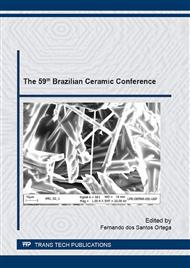[1]
A. Goldman: Modern Ferrite Technology. (Springer 2nd edition New York, 2006).
Google Scholar
[2]
A. Okamoto. The Invention of Ferrites and their Contribution to the Miniaturization of Radios. In GLOBECOM Workshops, 2009 IEEE, pp.1-6. DOI 10. 1109/GLOCOMW. 2009. 5360693.
DOI: 10.1109/glocomw.2009.5360693
Google Scholar
[3]
M.J. Vries: 80 Years of Research at the Philips Natuurkundig Laboratorium (1914-1994) The Role of the Nat. Lab. at Philips. Pallas Publications, Amsterdam, (2005).
DOI: 10.5117/9789085550518
Google Scholar
[4]
M.H. Makled, T. Matsui, H. Tsuda, H. Mabuchi, M.K. El-Mansy, K. Morii: Journal of Materials Processing Technology Vol. 160 (2005), p.229.
DOI: 10.1016/j.jmatprotec.2004.06.013
Google Scholar
[5]
J.M.D. Coey. Scripta Materialia Vol. 67 (2012), p.524.
Google Scholar
[6]
R.C. Pullar : Progress in Materials Science Vol. 57 (2012), p.1191.
Google Scholar
[7]
S. Ruoho, M. Haavisto, E. Takala, T. Santa-Nokki, M. Paju: IEEE Transactions on Magnetics Vol. 46 (2010), p.15.
DOI: 10.1109/tmag.2009.2027815
Google Scholar
[8]
M. Komuro, Y. Satsu, Y. Enomoto and H. Koharagi, Appl. Phys. Lett. Vol. 91 (2007), p.102503.
Google Scholar
[9]
M. Marinescu, A.M. Gabay, S. Kodat, J.F. Liu, G.C. Hadjipanayis. Sm-Co and Pr-Fe-B Magnets with Increased Electrical Resistivity. Proceedings of 20th International Workshop on Rare Earth Permanent Magnets and their Applications, Sept. 8-10, 2008, Crete, Greece. http: /www. electronenergy. com/media/REM%20Workshop-High%20Resistivity%20PM. pdf.
DOI: 10.1063/1.3058641
Google Scholar
[10]
U.S. Inan, R.A. Marshall: Numerical Electromagnetics the FDTD Method. (Cambridge University Press, 2011).
Google Scholar
[11]
M.A. Lantz et al.: IEEE Transactions on Magnetics, 2015. DOI 10. 1109/TMAG. 2015. 2435893.
Google Scholar
[12]
M.S. Walmer, M.H. Walmer, and C.H. Chen A new class of permanent-magnetic materials for high temperature applications in TWTs. Vacuum Electronics Conference 2000. DOI 10. 1109/OVE: EC. 2000. 847557.
DOI: 10.1109/ove:ec.2000.847557
Google Scholar
[13]
P. Eklund, S. Sjökvist, S. Eriksson and M. Leijon A Complete Design of a Rare Earth Metal-Free Permanent Magnet Generator. Machines Vol. 2 (2014) pp.120-133; doi: 10. 3390/machines2020120.
DOI: 10.3390/machines2020120
Google Scholar
[14]
J.D. Widmer, R. Martin, M. Kimiabeigi. Electric Vehicle Traction Motors Without Rare Earth Magnets. Sustainable Materials and Technologies Vol. 3 (2015), p.7.
DOI: 10.1016/j.susmat.2015.02.001
Google Scholar
[15]
B. Nykvist, M. Nilsson: Nature Climate Change Vol. 5 (2015), p.329.
Google Scholar
[16]
A. Honda, B. Fukuda, I. Ohyama, and Y. Mine: J. Mater. Eng. Vol. 12 (1990), p.41.
Google Scholar
[17]
A. Sumper, A. Baggini: Electrical Energy Efficiency: Technologies and Applications. (John Wiley & Sons United Kingdom, 2012).
Google Scholar
[18]
D. Liu, D. Hari, C. Vagg, L. Ash, S. Akehurst, C. J. Brace: Test and simulation of variable air gap concept on axial flux electric motor. In: VPPC 2013: The 9th IEEE Vehicle Power and Propulsion Conference, 2013-10-15 - 2013-10-18, Beijing. http: /dx. doi. org/10. 1109/ VPPC. 2013. 6671685.
DOI: 10.1109/vppc.2013.6671685
Google Scholar
[19]
S.C. Oh, J. Kern, T. Bohn, A. Rousseau, and M. Pasquier Axial Flux Variable Gap Motor: Application in Vehicle Systems. 2002. http: /www. autonomie. net/docs/6%20-%20Papers/ CIL/axial_flux_variable_gap_motor. pdf.
DOI: 10.4271/2002-01-1088
Google Scholar
[20]
P. Tenaud, A. Morel, F. Kools, J.M. Le Breton, L. Lechevallier: J. Alloys Compd. Vol. 370 (2004), p.331.
DOI: 10.1016/j.jallcom.2003.09.106
Google Scholar
[21]
B.M. Kirrane, L.S. Nelson and R.S. Hoffman: Basic & Clinical Pharmacology & Toxicology Vol. 99 (2006), 358.
Google Scholar
[22]
S.C. Chaudhary, A. Aggarwal, R. Avasthi: JIACM Vol 9 (2008), p.133.
Google Scholar
[23]
F.E. Luborsky: Journal of Applied Physics Vol. 37 (1966), p.1091.
Google Scholar
[24]
C. Yanar, J.M.K. Wiezorek, V. Radmilovic, W.A. Soffa: Metallurgical and Materials Transactions A Vol 33 ( 2002), p.2413.
Google Scholar
[25]
K.W. Moon, K.W. Jeon, Min Kang, M.K. Kang. Y. Byun, J.B. Kim, H. Kim, J. Kim: IEEE Transactions on Magnetics Vol 50 (2014), p.2103804 DOI: 10. 1109/TMAG. 2014. 2329555.
Google Scholar
[26]
J. Cui, J.P. Choi, G. Li, E. Polikarpov, J. Darsell, N. Overman, M. Olszta, D. Schreiber, M. Bowden, T. Droubay, M.J. Kramer, N.A. Zarkevich, L. L Wang, D.D. Johnson, M. Marinescu, I. Takeuchi, Q.Z. Huang, H. Wu, H. Reeve, N.V. Vuong, J.P. Liu: J. Phys. Condens. Matter Vol. 26 (2014).
DOI: 10.1088/0953-8984/26/6/064212
Google Scholar
[27]
M.F. de Campos, F. A.S. Silva: Mat. Sci. Forum Vol. 820 (2015), p.199.
Google Scholar
[28]
S.R. Janasi, M. Emura, F.J.G. Landgraf, D. Rodrigues: Journal of Magnetism and Magnetic Materials Vol 238 (2002), p.168.
Google Scholar


